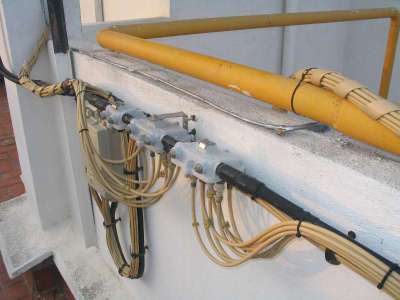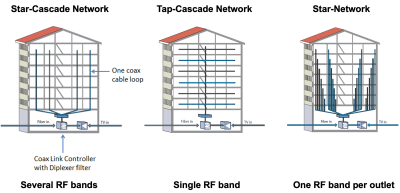
When it comes to networking these days, the vast majority of our devices are connected wirelessly. Beyond that, we’re all familiar with the Cat 5 and Cat 6 cables that form the high-capacity Ethernet networks in our homes, schools, and offices.
It’s only if you go back to the very dawn of Ethernet that coaxial cables are relevant… right? Wrong! MoCA networking is all about coaxial cables, designed to hook up devices over cable TV infrastructure!
Run What You Brung

America is the holy land of cable TV. Just 6.4% of Americans had cable TV by 1968, but that figure reached a full 62.4% by 1994. In those hallowed days, cable television was delivered as analog signals sent via coaxial cable runs.
These cables worked their way around the neighbourhoods of the nation, often being split or tapped to deliver cable TV services to yet more subscribers. Apartments and hotels would often have a distribution box with cable “drops” heading to each individual dwelling in the building. Individual homes would often have coaxial cable routed throughout to provide for multiple TVs in lounge rooms and bedrooms throughout.
Thus, in the United States, there are a huge number of buildings with coaxial cables sitting in the walls. Today, they’re often still in use, delivering cable TV and cable internet services. In this era, though, many coaxial outlets are going unused. Sometimes, it’s because the transition to digital cable meant that a separate set-top box was needed per TV, adding expense. Other times, it’s simply because cable TV has been supplanted in some respects by the rise of streaming services.

This wide base of installed coax led to the devleopment of MoCA, a network standard intended to use these cable runs. 1.0 edition equipment first became available in 2006. MoCA stands for the Multimedia over Coax Alliance, and the technology was initially developed to send video over IP via existing coaxial cable runs. That use case didn’t really eventuate, but the underlying technology was sound.
Instead, the MoCA standard was developed into a networking technology to carry Ethernet over coaxial cabling. These days, it’s primarily touted as a solution to home networking problems. Common scenarios include when WiFi signals may not reach across a home, or where it’s desirable to get a wired network connection into a given room. MoCA can potentially help in these instances if coax hookups are available. Often, it involves hooking up a router to a MoCA adapter at one coaxial outlet in the house. Then, a MoCA WiFI extender or network adapter is hooked up at the other end to provide connectivity at the remote outlet.

The MoCA concept may sound curious, given that Ethernet was originally carried over coax cables in its earliest iterations. Back then, the various standards for coax ethernet were colloquially known as thicknet and thinnet depending on the diameter of coaxial cable used. However, MoCA differs, as it was developed for a different use case. MoCA networking had to be able to run on coaxial cables that may still be in use for cable TV or cable internet delivery.
Functionally, this meant that MoCA signals had to avoid stepping on cable TV bandwidth, or interfering with DOCSIS cable internet signals. MoCA achieves this by simply running on frequencies not traditonally used by cable TV. In the case of DOCSIS internet though, special measures had to be taken to make the standards interoperable. Special filters are often also used to prevent MoCA signals from reaching other cable network users beyond the dwelling or building intended.
The first 1.0 version of the standard allowed for half-duplex operation at up to 100 Mbit/s, and could handle up to eight nodes. MoCA 1.1 was released in 2007, bumping speeds to 175 Mbit/s and adding capability to handle 16 nodes.
MoCA 2.0 further increased speed to 500 Mbit/s, or 1 Gbit/s in a bonded mode, while achieving latency of 3.6 ms. MoCA 2.1 later added bridge detection to avoid neighbours accidentally forming networks together, while also adding power saving features. MoCA 2.5 included the MoCA Access development, intended for facilities like hotels, hospitals, or other facilities with existing sprawling coax networks. It offered networking at up to 2.5 Gbit/s down, 2.0 Gbit/s up, and provisions for up to 32 nodes.
MoCA 3.0 was later released in 2021, able to achieve up to 10 Gbit/s operation. However, achieving these speeds requires using the entire bandwidth available on the coaxial cable. Thus, only lower speeds can be used in concert with cable TV or cable internet on the same lines.
MoCA Networking Is A Niche Solution For Coax Lovers
Source: Manila Flash Report
0 Comments